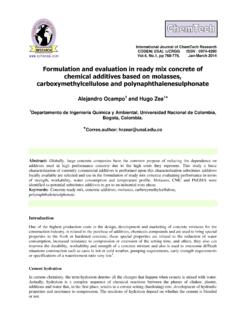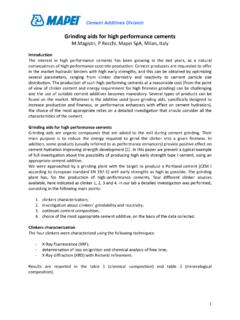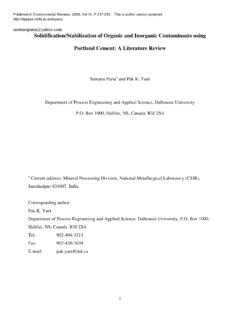Transcription of A Comparison Study of Portland Cement Hydration Kinetics ...
1 1 A Comparison Study of Portland Cement Hydration Kinetics as Measured by Chemical Shrinkage and Isothermal Calorimetry Xueyu Panga*, Dale P. Bentzb, Christian Meyerc, Gary P. Funkhousera, Robert Darbea a: Halliburton, 3000 N Sam Houston Pkwy E, Houston, TX 77032, USA b: Engineering Laboratory, National Institute of Standards and Technology, USA c: Department of Civil Engineering and Engineering Mechanics, Columbia University, USA *: Corresponding author. Email: (X. Pang) ABSTRACT Two different methods of evaluating Cement Hydration Kinetics , namely chemical shrinkage and isothermal calorimetry tests, are used to investigate the early stage Hydration of different classes of oilwell Cement at various temperatures.
2 For a given Cement paste, the Hydration Kinetics curves measured by the two methods are proportional to each other at the same curing temperature. The ratio of heat of Hydration to chemical shrinkage for different cements used in this Study ranges from 7500 J/mL to 8000 J/mL at 25 C and increases almost linearly with increasing curing temperature at a rate that varies only slightly with Cement composition (approximately 58 J/mL per C). A previously proposed scale factor model for simulating the effect of curing temperature and pressure on Cement Hydration Kinetics is further validated in this Study for its temperature aspect.
3 The model is shown to be particularly helpful in correcting for slight temperature errors in the experiments. Keywords: Cement Hydration ; chemical shrinkage; heat of Hydration ; isothermal calorimetry; oilwell Cement . 2 1. Introduction The Hydration of Portland Cement is a complex process. Despite decades of research, many detailed features are still not clearly understood today, primarily because of the complicating influences of different clinker phases, impurities, and their interactions.
4 Nevertheless, the general Hydration Kinetics of Cement is often represented by the rate of change of the overall degree of Hydration , which is defined as the total weight fraction of Cement reacted. As a composite material consisting mainly of four compounds, or clinker phases (C3S, C2S, C3A and C4AF1), the overall degree of Hydration of Cement is typically written as [1]: 33223344C SC SC SC SC AC AC AFC AFtptptptpt (1) where pi is the original weight fraction of Phase i in the anhydrous Cement and i(t) is the degree of Hydration of Phase i at time t.
5 Direct determination of i(t) can be made by quantitative X-ray diffraction analysis (QXDA) [1, 2], though it is difficult to obtain accurate results. Some properties of a hydrating Cement paste, such as the non-evaporable water content, the cumulative heat evolution and the total chemical shrinkage have been shown to have approximately linear relationships with the overall degree of Hydration [1, 3-5]. As a matter of fact, is more easily and commonly determined indirectly by tracking the time dependence of one or more of these properties.
6 For the purposes of this paper, the semi-continuous measure of the progress of the degree of Hydration with time ( (t)) and its derivative (d (t)/dt) are both referred to as the Hydration Kinetics curves. Among the different methods of approximating Cement Hydration progress, heat of Hydration tests used to be the only one that provided continuous data suitable for evaluating Hydration mechanisms. Automated chemical shrinkage test methods have been developed in 1 Cement chemistry notation: C=CaO, S=SiO2, H=H2O, A=Al2O3, F=Fe2O3 3 recent years [6-9] and are now also frequently used to Study Cement Hydration mechanisms [9-12].
7 Therefore, it is important to investigate the differences and similarities between these two different methods, which may also help us gain further insights about the Cement Hydration process. The experimental test methods and detailed test plan of this Study are described in the next section. The theoretical analysis regarding the correlation between heat of Hydration and chemical shrinkage is presented in Section 3. Because temperature control of the chemical shrinkage tests performed in this Study was not very accurate, a method of correcting the temperature differences between isothermal calorimetry tests and chemical shrinkage tests is also proposed in Section 3 based on a scale factor model developed earlier.
8 The scale factor model was developed to simulate the effect of curing temperature and pressure on Cement Hydration Kinetics and has been preliminarily validated using chemical shrinkage test data [12]. When the Hydration Kinetics curve of a reference curing temperature is known for a given Cement paste, the scale factor model can be used to estimate the Hydration Kinetics curve for a given temperature or the temperature of a given Hydration Kinetics curve. In section , the model is further validated with isothermal calorimetry test data from this Study .
9 Since the rate of Hydration is measured directly in these tests, the accuracy and limitations of the scale factor model can be observed and discussed in greater detail. In section , it is shown that the Hydration Kinetics measured by chemical shrinkage can be correlated excellently with those measured by isothermal calorimetry by applying the proposed model in this Study . 2. Materials and Methods Materials 4 Oilwell cements are based upon Portland Cement , but manufactured to a higher level of consistency from one production batch to another.
10 There are no substantial differences between oilwell cements and ordinary Portland cements, except for the fact that some Class H (API Specification 10A [13]) Cement may have near zero C3A content. API Classes A, B, and C cements are similar to ASTM Types I, II, and III cements, respectively. The Hydration Kinetics of four different classes of oilwell cements, namely Class A, C, G, and H, were investigated at different curing temperatures in this Study . All slurries ( Cement pastes) were prepared with de-aerated water and Cement only, with no additives.









